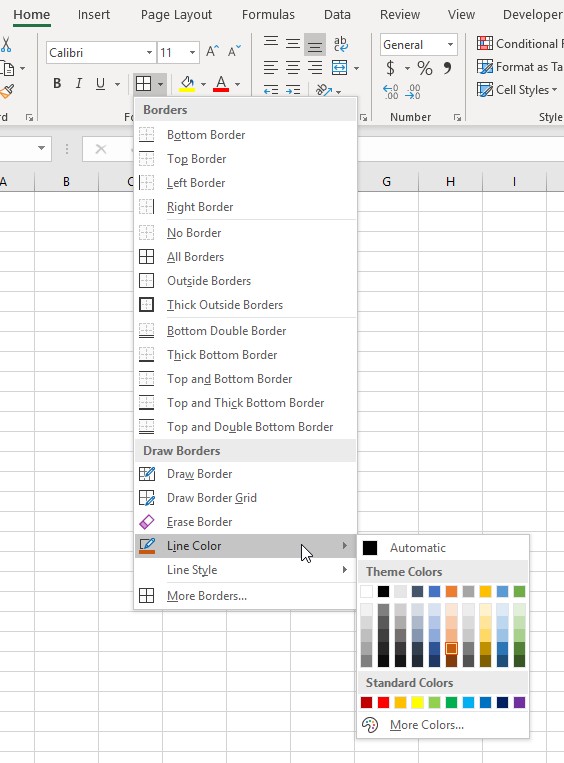Please Note: This article is written for users of the following Microsoft Excel versions: 2007, 2010, 2013, 2016, 2019, 2021, 2024, and Excel in Microsoft 365. If you are using an earlier version (Excel 2003 or earlier), this tip may not work for you. For a version of this tip written specifically for earlier versions of Excel, click here: Changing the Color of a Cell Border.
Written by Allen Wyatt (last updated December 6, 2025)
This tip applies to Excel 2007, 2010, 2013, 2016, 2019, 2021, 2024, and Excel in Microsoft 365
You probably already know that Excel allows you to add borders to your cells. This is handy for separating different pieces of information within the same data table and for, well, just making your data look better.
You are not limited to black borders, however. You can specify different colors for your borders by following these steps:

Figure 1. The Border tab of the Format Cells dialog box.
Just as you can specify a different border type for each side of a cell, you can also specify a different border color for each side of the cell. Just make sure you pick the color you want used before you click on the side of the cell where you want that color used.
Another way you can change the border color is to use the border drawing tools Excel provides. Just display the Home tab of the ribbon and then click the down-arrow next to the Borders tool (in the Font group). Excel displays a whole bunch of choices for applying borders. (See Figure 2.)

Figure 2. Drawing using a border color.
The option you are interested in is the Line Color option. Hover over it, and you'll see a palette of colors you can choose. Pick the color you want, and Excel kicks into border-drawing mode. (You can tell because the mouse pointer changes to a small pencil shape.) Move near the border you want, hold down the mouse button, and drag the mouse. The border is drawn on the cells as you specify. When you press Esc to exit border-drawing mode, any borders you subsequently apply (by whatever means) are applied in the same color you selected.
ExcelTips is your source for cost-effective Microsoft Excel training. This tip (8773) applies to Microsoft Excel 2007, 2010, 2013, 2016, 2019, 2021, 2024, and Excel in Microsoft 365. You can find a version of this tip for the older menu interface of Excel here: Changing the Color of a Cell Border.

Best-Selling VBA Tutorial for Beginners Take your Excel knowledge to the next level. With a little background in VBA programming, you can go well beyond basic spreadsheets and functions. Use macros to reduce errors, save time, and integrate with other Microsoft applications. Fully updated for the latest version of Office 365. Check out Microsoft 365 Excel VBA Programming For Dummies today!
When you display a time in a cell, Excel normally displays just the hours, minutes, and seconds. If you want to display ...
Discover MoreWant to repeat cell contents over and over again within a single cell? Excel provides two ways you can duplicate the content.
Discover MoreOne of the most common cell alignment settings I use is the one to center across a selection. If you want to vary how ...
Discover MoreFREE SERVICE: Get tips like this every week in ExcelTips, a free productivity newsletter. Enter your address and click "Subscribe."
2025-12-14 08:48:59
SAndeep kothari
Thanks Woolley.
2025-12-13 10:45:44
J. Woolley
@sandeepkothari
See https://learn.microsoft.com/en-us/office/vba/api/excel.range.borders
And https://learn.microsoft.com/en-us/office/vba/api/excel.borders#properties
2025-12-12 21:23:36
sandeepkothari
What is the VBA way for Changing the Color of a Cell Border?
2025-12-10 09:46:15
Mike D.
I did know of this but never used it before. I tried this on a pivot table and then tried sorting, it stayed with the cell, not the data.
I also tried it on a non-pivot table sort, and the same thing happened.
Is this an unbreakable bond?
2025-12-07 05:41:10
Mike J
@Walter Costello
ASAP Utilities has a macro for this, but this link may also solve the problem:-
https://superuser.com/questions/1232028/deleting-unused-excel-custom-styles-in-bulk-how
2025-12-06 05:18:18
Walter Costello
Too many different cell formats. In a fixed asset register spreadsheet, I want to indicate the US$ on the currency amounts column but keep getting this note. How do you get around this please.
Walter Costello
Got a version of Excel that uses the ribbon interface (Excel 2007 or later)? This site is for you! If you use an earlier version of Excel, visit our ExcelTips site focusing on the menu interface.
FREE SERVICE: Get tips like this every week in ExcelTips, a free productivity newsletter. Enter your address and click "Subscribe."
Copyright © 2025 Sharon Parq Associates, Inc.
Comments